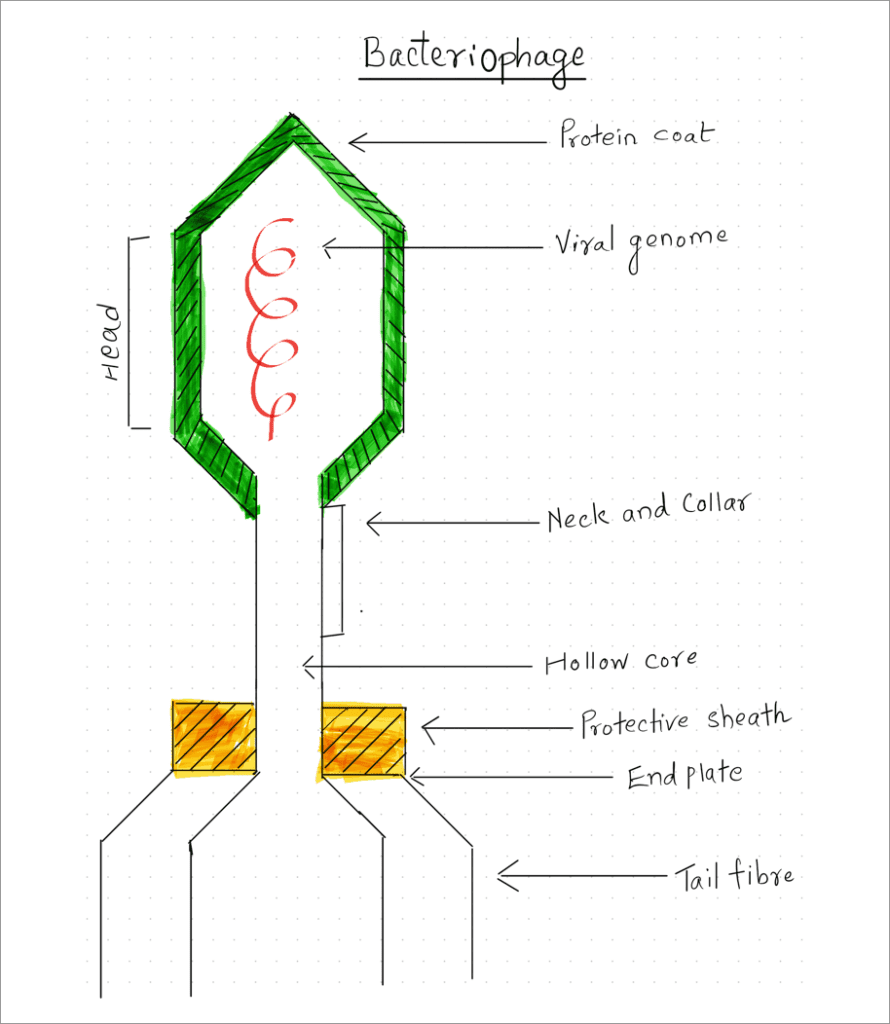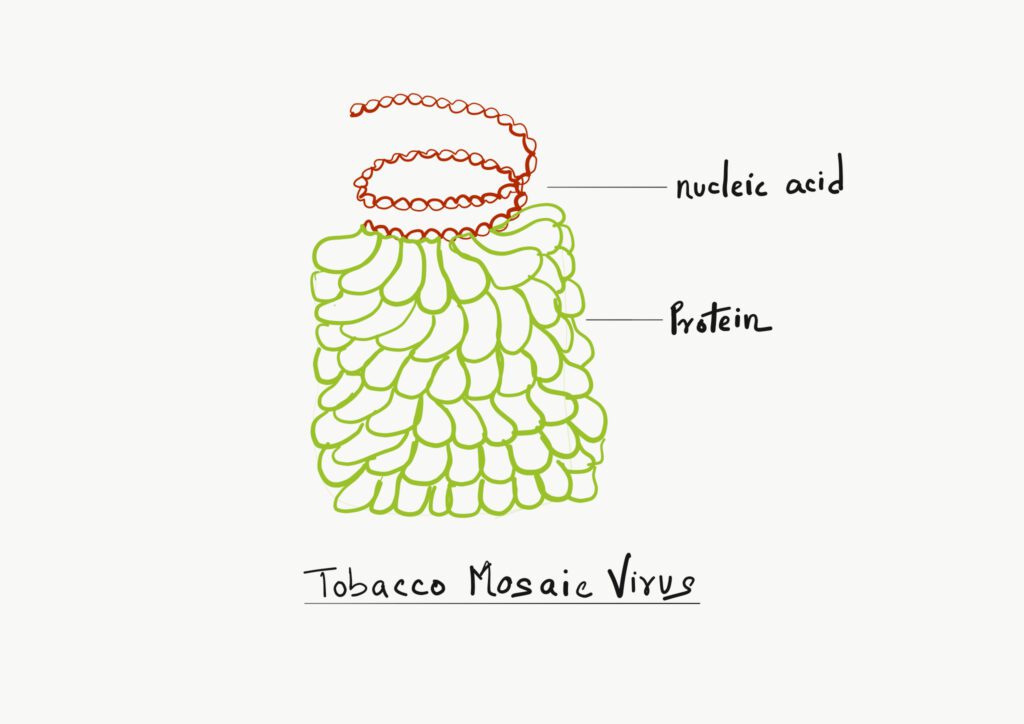
Introduction
There is no nomenclature system for virus classification since they are not considered truly living. As we all know living organisms have a definite cellular structure. That raises an interesting question of what actually viruses are. And what are the types of viruses and their structure?
Viruses are named according to the type of host like plant viruses, animal viruses, bacteriophages,s, etc to carry on the lifecycle of the disease caused. For example, poxvirus or some coded systems like T1, and T2 phages. Thus, the virus is generally classified into three classes.
Below is the virus classification in short with their mode of reproduction, host type, and simple diagrams of each.
Types of viruses
1. Bacterial viruses or bacteriophage
Bacteriophages, as the name suggests, are those viruses that infect bacteria. The word bacteriophage is derived from two words namely bacteria and phage “to eat”.
Some examples of common bacteriophages are as follows
a. T4 Bacteriophages

They are generally tadpole-shaped. Mainly comprises capsids with an icosahedral head, a short neck with a collar, and a long helical tail. The tail has 6 long fibers with a hollow midpiece and a hexagonal or dome-shaped base plate or endplate. The tail tube of T4 Bacteriophages is made up of gp19 polymerized protein. It is capped by tail tube terminator protein gp3 hexamer. And the contractile sheath is made up of protein gp18 (1). The tail fiber, collar, and whisker are made up of gp34, gp35, gp36, and gp37 proteins.
The T4 genome or chromosome is a single DNA molecule which 60 micrometers long and is packed tightly within the head. The T4 DNA codes for at least 30 different types of enzymes to ensure the rapid replication of the phage chromosomes.
b. M13 bacteriophage

It is a filamentous bacteriophage with circular DNA and infects E. coli bacteria. Genetic recombination experiments use bacteriophages as a cloning vector. The single-stranded DNA molecules are packed inside rod-shaped protein capsids.
2. Plant viruses
Plant viruses are types of viruses that affect plants or depend upon the plants to complete their life cycles. It disturbs the plant’s metabolism and causes serious damage. Some of the important plant viruses are tobacco mosaic virus (TMV), tobacco rattle virus (TRV), potato virus, southern bean mosaic virus (SBMV), and turnip yellow virus (TYV). Notable plant diseases caused by viruses are a leaf roll of tomato, a black-ring spot of cabbage, and a little leaf of brinjal. Some examples of plant viruses are
a. TMV virus

This is known as the tobacco mosaic virus one of the first discovered viruses having RNA as nucleoprotein. It is a rod-shaped helical symmetry virus. TMV infects the leaves of tobacco. The infection is caused by some host or vector or mechanical means like rubbing or handling. TMV has a cigarette-like shape with a length of 3000 Angstrom.
The reproduction cycle of TMV
TMV once when gets inside the host starts synthesizing its own protein and replicates its RNA molecule. After the synthesis of this raw material, the assembly started and numerous viruses formed and released after the lysis of the host.
b. Potato virus Y

This is an aphid-borne virus that causes yield loss and affects tuber quality. Potato virus Y is a filamentous-shaped RNA virus with a length of 400-800 nm. The common symptoms of PVY-affected plants are leaf drop and acropetal necrosis.
Reproduction of PVY
Penetrates host cell unwinds its viral genetic material. Use the host cell mechanism and material for its RNA replication and protein synthesis. Assemble and release from the host.
c. Cucumber mosaic virus (CMV)
This is a single-stranded RNA virus that infects the plants of the family Cucurbitaceae, tomato, potato, and spinach. The main symptoms of CMV are leaf mottling, crinkling, and curling of edges that occur on cucumbers. Petioles and internodes are shortened resulting in the stunted and compact appearance of the plant.
Reproduction of CMV
Replication takes place in the cytoplasm. Host cells recognize the virus and it gets attached to it. The virus then gets un-coats the capsid and releases the genomic RNA into the cytoplasm. RNA1 and RNA2 encode protein la and protein 2a, respectively. New virions are assembled after the completion of protein synthesis. Finally, virions are released by lysis of the infected host cell.
3. Animal viruses
This virus infects animal cells and causes fatal diseases to animals and human beings. The genetic material of animal viruses is either DNA or RNA. An envelope is surrounded around the protein coat or capsid of animal viruses.
Some examples of animal viruses are the common cold, influenza, chickenpox, polio, mumps, rubella.
a. Influenza virus

There are generally four main types of influenza viruses namely influenza viruses A, B, C, and D. Influenza virus A infects ducks, chickens, pigs, whales, and horses. Hemagglutinin (H) and neuraminidase (N) are the two subtypes of Influenzavirus A. Classification is due to proteins on the surface of Influenza. Common human influenza circulated widely is mainly B influenza. Influenza type C causes mild respiratory illness. But not thought to cause epidemics. Influenza D viruses primarily affect cattle and it is not known to infect or cause illness in people.
b. Poliomyelitis
Poliomyelitis is an animal-origin virus having RNA as genetic material. It infects humans and spread from one human to another. The virus lives in an infected person’s throat and intestines. It enters the body through the mouth and spreads through contact with the feces (poop) of an infected person and, though less common, through droplets from a sneeze or cough.
This virus has a protein shell in a spherical form with 60 asymmetrical proteins. This shell or capsid has a single RNA molecule with 5200 nucleotides.
c. Herpesvirus
It is DNA containing a human virus with an icosahedral capsid having 162 capsomeres. The DNA of this virus is single and linear double-stranded and codes about 100 average-sized proteins.
Why is a virus, not a living thing?
Viruses are not classified or do not have a scientific name like other plants, animals, and bacteria do. This is because there is still a huge question of whether they are viruses living or nonliving. Some believed that they were not truly living. As viruses do not have a cell structure. They are therefore non-cellular organisms having inert crystalline structures outside the living cells.
Reference
